Abstract
The archaeological biography of the site of Heliopolis starts at the very beginning of its secular history. In spite of its major role in European perceptions of ancient Egyptian culture, until now only little is known about the ancient metropolis, as no systematic excavations were undertaken here until recent times.
The aim of this paper is to shed light on the relation between the excavations conducted at Matariya/Heliopolis by the M.A.I (Missione Archeologica Italiana) between 1903 and 1906 and the archaeological investigations currently being conducted at the site by the Egyptian-German mission, focusing on the case study of the economic precinct of the Late to Ptolemaic Period (Area 232) in the main temple temenos of the sun god.
Thanks to an ongoing dialogue between past and current excavations, for the first time ever it is now possible to understand the architectural evolution of the site and situate some of Ernesto Schiaparelli’s most remarkable finds now stored in the Museo Egizio (Italy), including the fragments of the naoi of Djoser and Sethi I, within their original archaeological context.
1. Introduction (Federica Ugliano)
Heliopolis, the City of the Sun, was believed in ancient times to be central to the creation of the world.1 Despite its outstanding religious, political and economic role, its monumental remains have not been spared by severe plundering. In Graeco-Roman times, many statues, obelisks and sphinxes were taken to Alexandria, Rome and other cities as spoils.2 Moreover, starting in the Late Roman Period, Heliopolis was quarried for the construction of Cairo.3
Since the first scientific documentation of pharaonic monuments by European travellers in the late 18th century,4 many scholars have identified and mapped the original remains of Heliopolis. Its main distinctive and still preserved landmarks are the Obelisk of Senusret I, the perimeter of the precinct wall (surrounding the sacred and administrative area) and the northern sector of the temenos, which has many mounds. Nowadays the archaeological site is located in the north-eastern periphery of Cairo, lying beneath the modern districts of Matariya, Arab el-Hisn, Ain Shams and Arab el Tawil (Fig. 1).
The archaeological site of Heliopolis; from Petrie and Mackay, Heliopolis, 1915, pl. I created by the author with QGIS (QGIS.org, 2021. QGIS Geographic Information System. QGIS Association. http://www.qgis.org). © Federica Ugliano, based on Esri Satellite Imagery.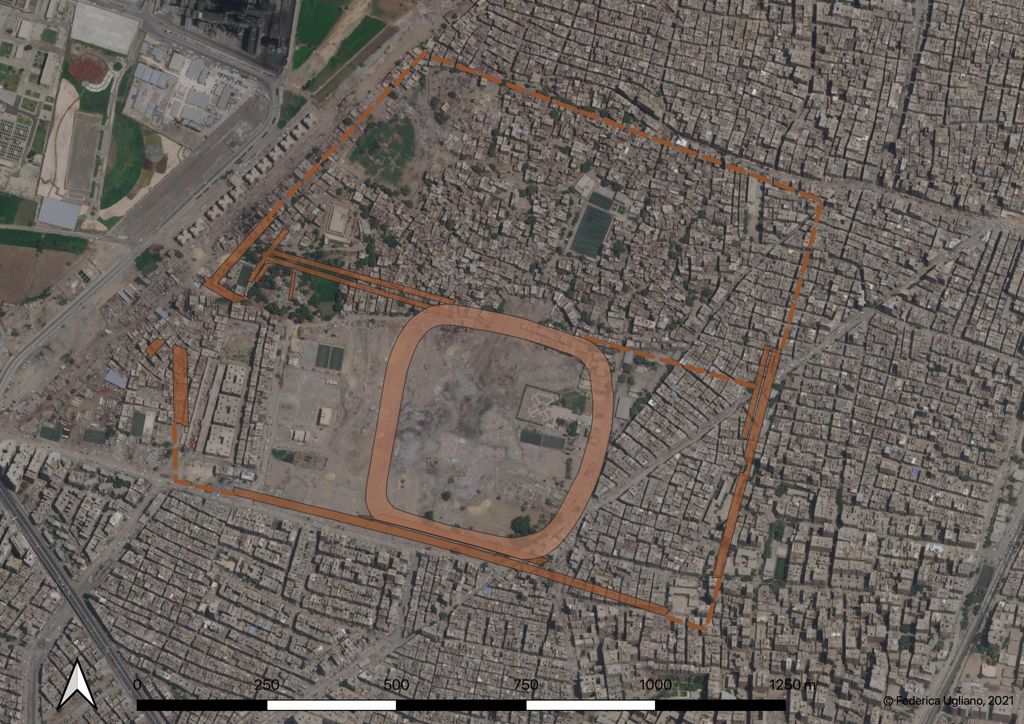
Fig. 1
Many archaeological investigations have been carried out on the site since 1840s,5 but only at the beginning of the 20th century did the M.A.I. (Missione Archeologica Italiana), led by Ernesto Schiaparelli (director of the Museo Egizio), start an extensive programme of excavations.6
Thanks to his close relationship with Gaston Maspero and a general lack of interest in the site by other foreign missions,7 in 1902 Schiaparelli obtained the concession to excavate the ancient remains of Heliopolis.8
Because the area was comprised of public land and various private holdings, a uniform conservation effort was far from guaranteed. Besides that, the geological nature of the land itself – which has an extremely high water-table – threatened the integrity of the site.9 The ownership and natural features made the preservation of the site’s archaeological evidence a pressing and critical issue.
Despite all these difficulties, the M.A.I carried out four archaeological campaigns at the site between 1903 and 1906.10 More than 1500 inventory numbers11 were assigned to the artefacts brought back to Italy thanks to the so-called partage system,12 and all the objects were registered by Schiaparelli in a manuscript inventory according to the different excavated areas (Fig. 2): the temple (Suppl. 2671-2867), the Mnevis temple (Suppl. 2868-2879), the kôm (Suppl. 2880-3844), the necropolis (Suppl. 3845-3877), the prehistoric village (Suppl. 3878-4196) and the “pyramid” (Suppl. 4197-4221).13
The manuscript inventory. © Archivio di Stato, Torino, Fondo MAE, Secondo Versamento, Secondo Mazzo, Fascicolo 2.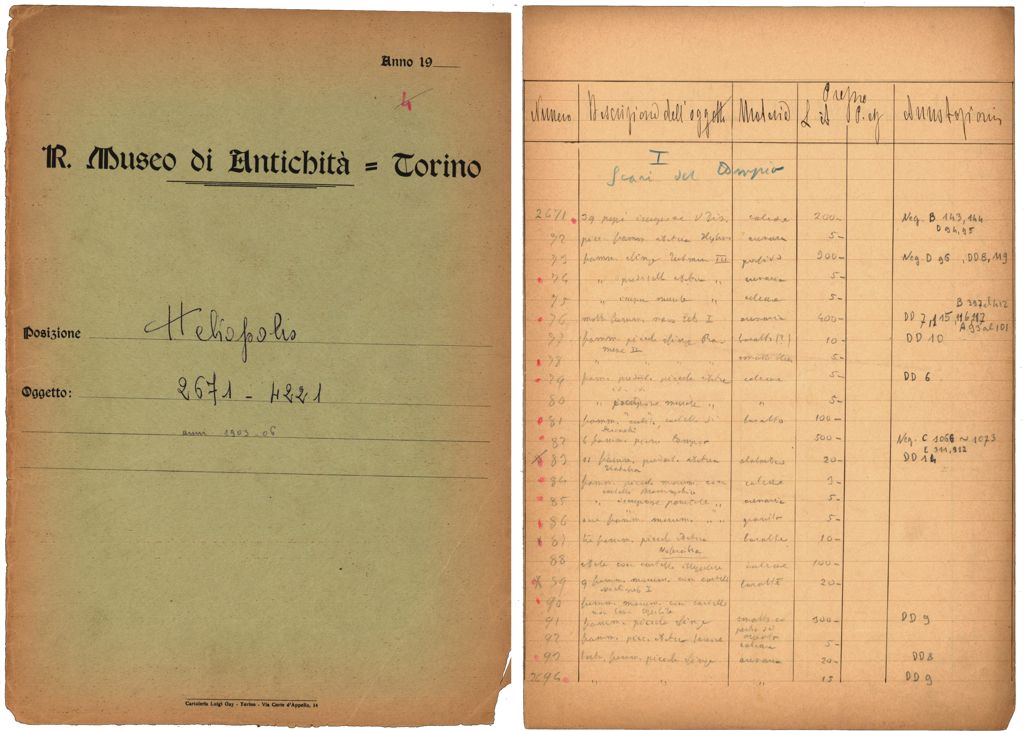
Fig. 2
Regardless of his extensive work, Schiaparelli never published the results of his excavations.14 He did, however, leave several notes, excavations diaries, letters and photographs (Fig. 3): a rich corpus which, unfortunately, is nowadays split among several Italian institutions.15
Selection of archival documents: Francesco Ballerini’s excavation diaries; letter from Francesco Ballerini to Ernesto Schiaparelli (19/05/1904); copy of the hieroglyphic inscriptions of the obelisk of Senusret I by Francesco Ballerini; photographic plate of one of the trenches excavated in the “tempio del Sole” area (1904). © Archivio di Stato, Torino, Fondo MAE, Terzo Versamento; © Archivio Fotografico, Museo Egizio, C01404.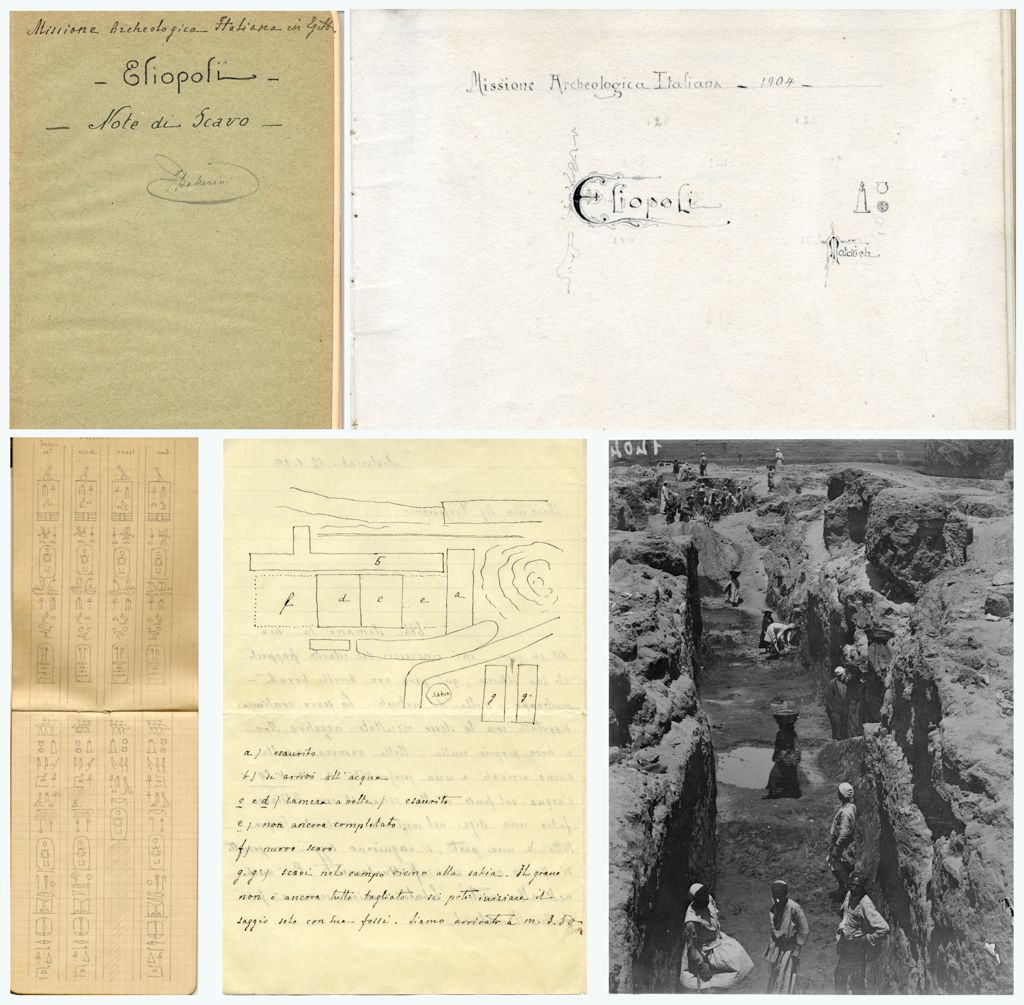
Fig. 3
The dispersal of the Heliopolis documentation has discouraged many scholars in past and recent times from any attempt at reconstructing in detail the history of the Italian excavations at this site. We consequently lack a general plan of the excavated area indicating the original trenches dug out by Schiaparelli
A first effective means of overcoming these difficulties was to go back to the primary archived documentation. For this reason, among more than 1700 documents concerning the M.A.I. excavations at Heliopolis, stored in five main Italian institutions,17 571 were selected as relevant to the present study.18 These selected documents were photographed/scanned, filed and transcribed. Thus, for the first time, this highly heterogenous material could be synoptically analysed (Tab. 1).
Archival documents selected for the present study, divided by type. © Federica Ugliano.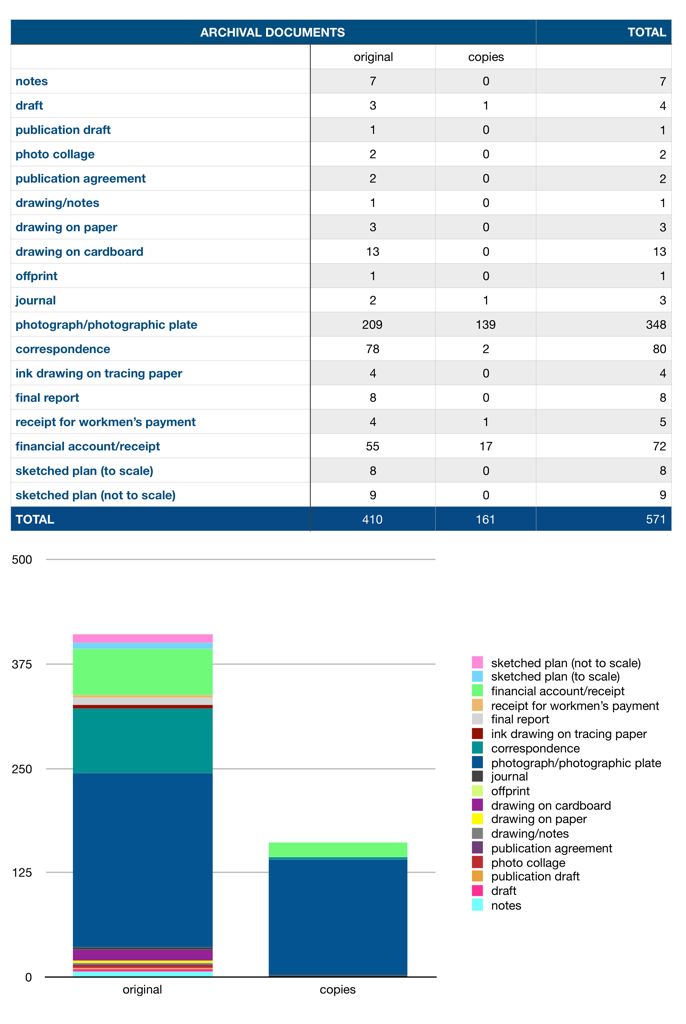
Tab. 1
To get the complete picture, however, the letters, drafts, diaries, economical accounts, and official and unofficial reports needed to be cross-correlated with the sketch plans, maps, photographs and artefacts. A “holistic” view19 proved to be essential in order to reassess the role of the Italian Archaeological Mission and fill the current gaps in the history of the excavations at Heliopolis.
Thus, our re-contextualisation of the artefacts found by Schiaparelli and his team started from the basic notion of context. After having identified the “macro” areas as indicated in the Manuscript Inventory, thanks to the accuracy of the sketches drawn by Francesco Ballerini20 (Schiaparelli’s main assistant and field director), it was finally possible to re-locate most of the original excavation trenches and geo-reference them with GIS software (Fig. 4).21
Area investigated by the Italian Archaeological Mission between 1903 and 1906, created by the author with QGIS (QGIS.org, 2021. QGIS Geographic Information System. QGIS Association. http://www.qgis.org). © Federica Ugliano.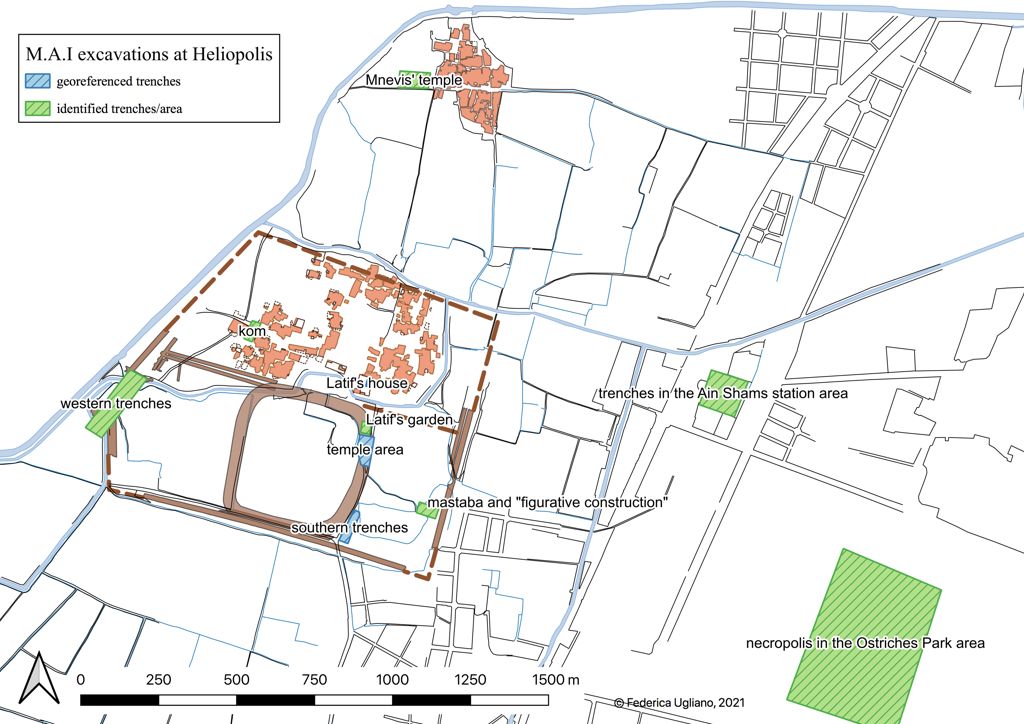
Fig. 4
2. A case study: the “Tempio del Sole” (Federica Ugliano)
Among the many remarkable discoveries of the M.A.I., an especially noteworthy one is a huge mud-brick structure of the most peculiar form. It was unearthed during the 1903–1905 campaigns in several of the trenches excavated starting less than 100 m east of the obelisk, and which extended northward into a private garden (known as Latif’s Garden) and
Trenches excavated by the Italian Archaeological Mission in the “tempio del Sole” area, created by the author with QGIS (QGIS.org, 2021. QGIS Geographic Information System. QGIS Association. http://www.qgis.org). © Federica Ugliano, based on the 1:5000 cadastral map (sheet n° IV-VII-3) published by the Survey of Egypt in 1917, retrieved on https://digital.staatsbibliothek-berlin.de/werkansicht/?PPN=PPN1027499791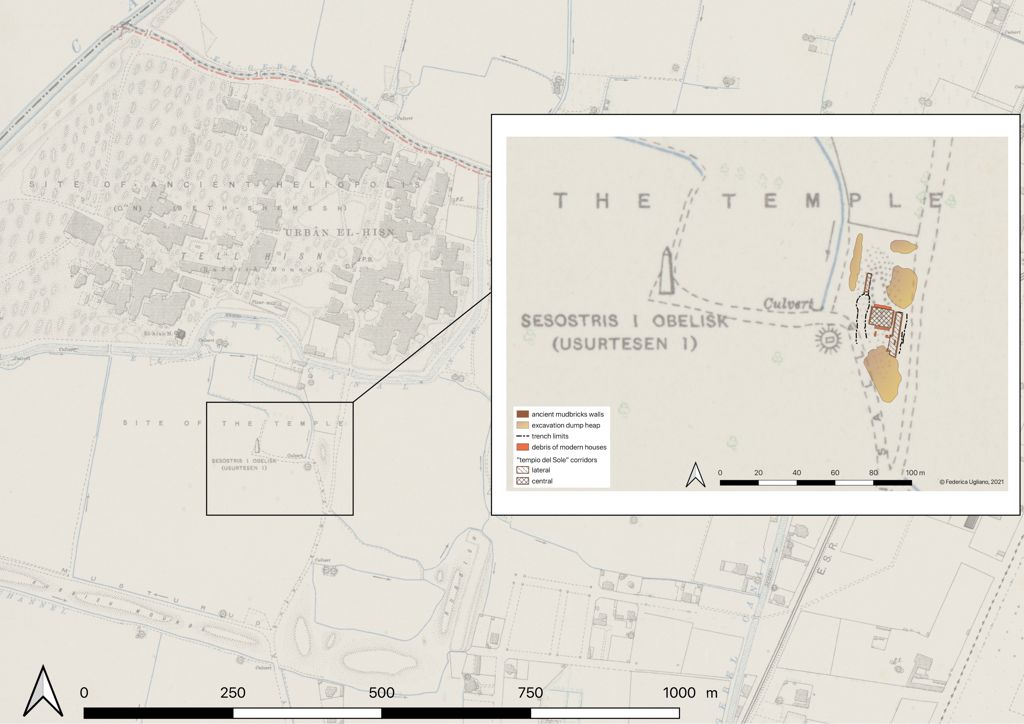
Fig. 5
Aerial photograph of the temple area and of the northern kom taken by the Royal Air Force on 29th June 1925; east of the obelisk of Senusret I, the traces of Schiaparelli’s and Petrie’s excavation trenches are still visible. © UCL, Institute of Archaeology Collections, Air Survey Photographs, Box 255 (UCL0093568), n. AP1323.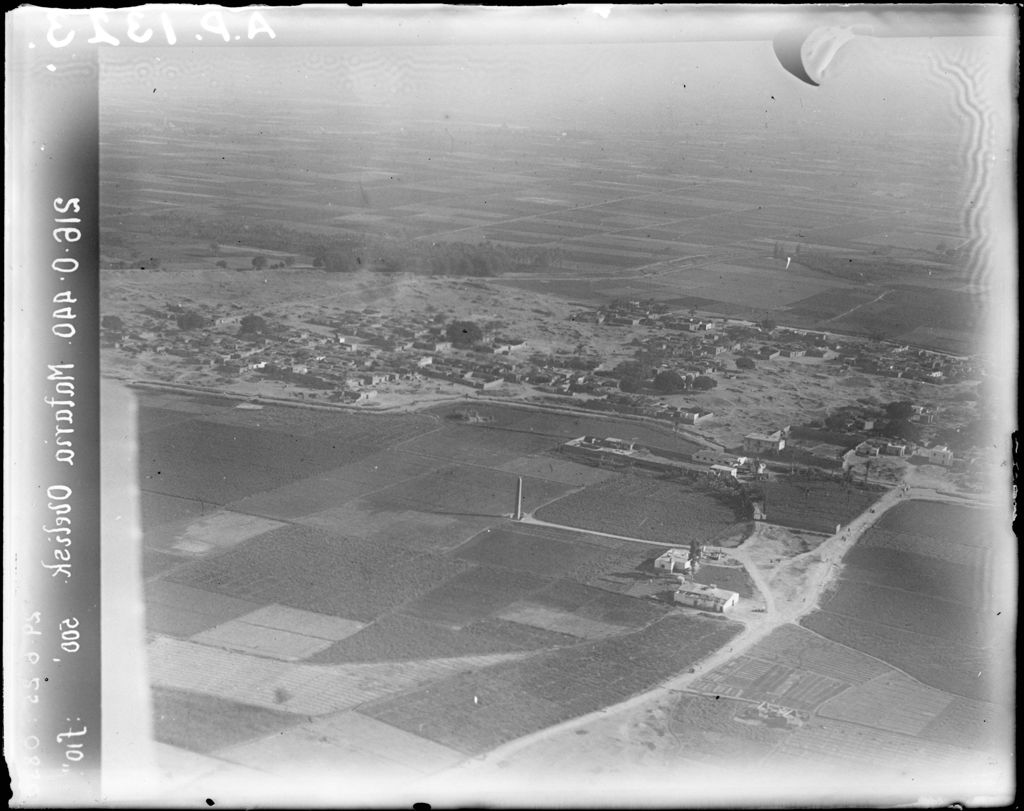
Fig. 6
According to the final report that Schiaparelli and Ballerini wrote to the king in 1904:22
But even more unexpected than the architectural structure of the building itself (Fig. 7) was the discovery of an extremely rich hoard of demolished temple inventory:
Section of the “tempio del Sole”; from Schiaparelli and Ballerini, “Missione Archeologica Italiana in Egitto”, 1904, p. 21 created by the author; historical photographs of the wooden model of the “tempio del Sole” commissioned by Schiaparelli and preserved in the Museo Egizio (Provv. 8274). © Federica Ugliano; Archivio di Stato, Torino, Fondo MAE, Terzo Versamento.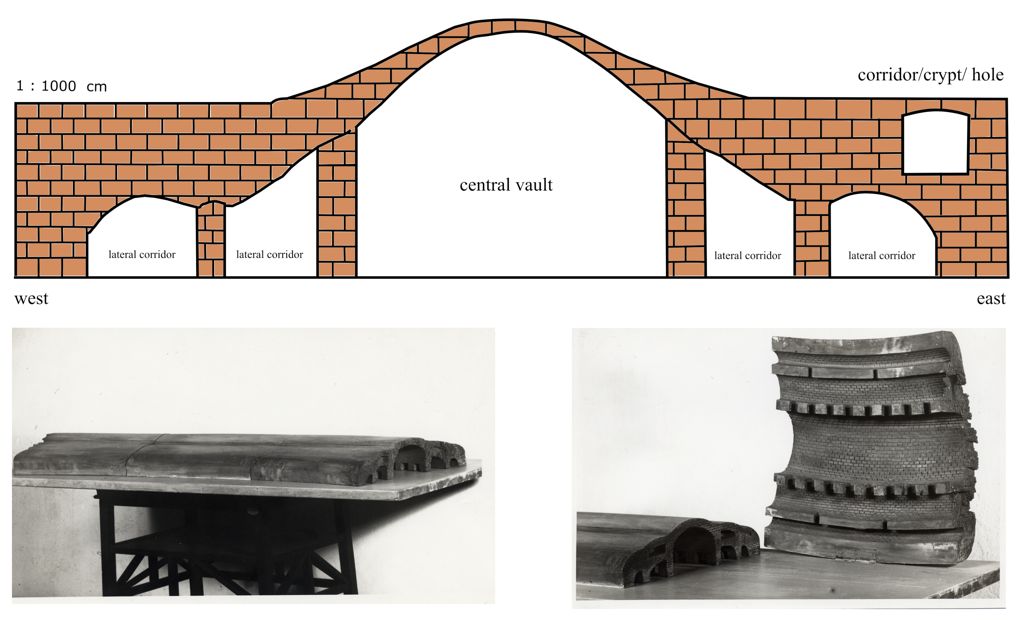
Fig. 7
Among the artefacts found in what Schiaparelli later re-interpreted as a “buca” (hole) in the masonry,24 there were some of the most significant and unique artefacts uncovered in Heliopolis25 (Fig. 8): among them, 2 fragments of a small sphinx with the cartouche of Thutmosis III (Suppl. 2673);26 about 300 fragments of a granite naos, dedicated by Seti I (Suppl. 2676);27 39 fragments of a naos (or naoi) dedicated by Djoser to several gods (Suppl. 2671);28 a fragment of a cubit with the cartouche of Sheshonq I and some of the names (only seven preserved) of Upper Egyptian nomes (Suppl. 2681);29 5 fragments of an engraved tablet with the inventory and the plan of a temple (Suppl. 2682);30 and a remarkable fossilized sea urchin (Suppl. 2761) that is of special note, as its inscription mention its discovery by a god’s father Tjanefer.31
Selection of artefacts uncovered by the Italian Archaeological Mission in the so-called “buca”.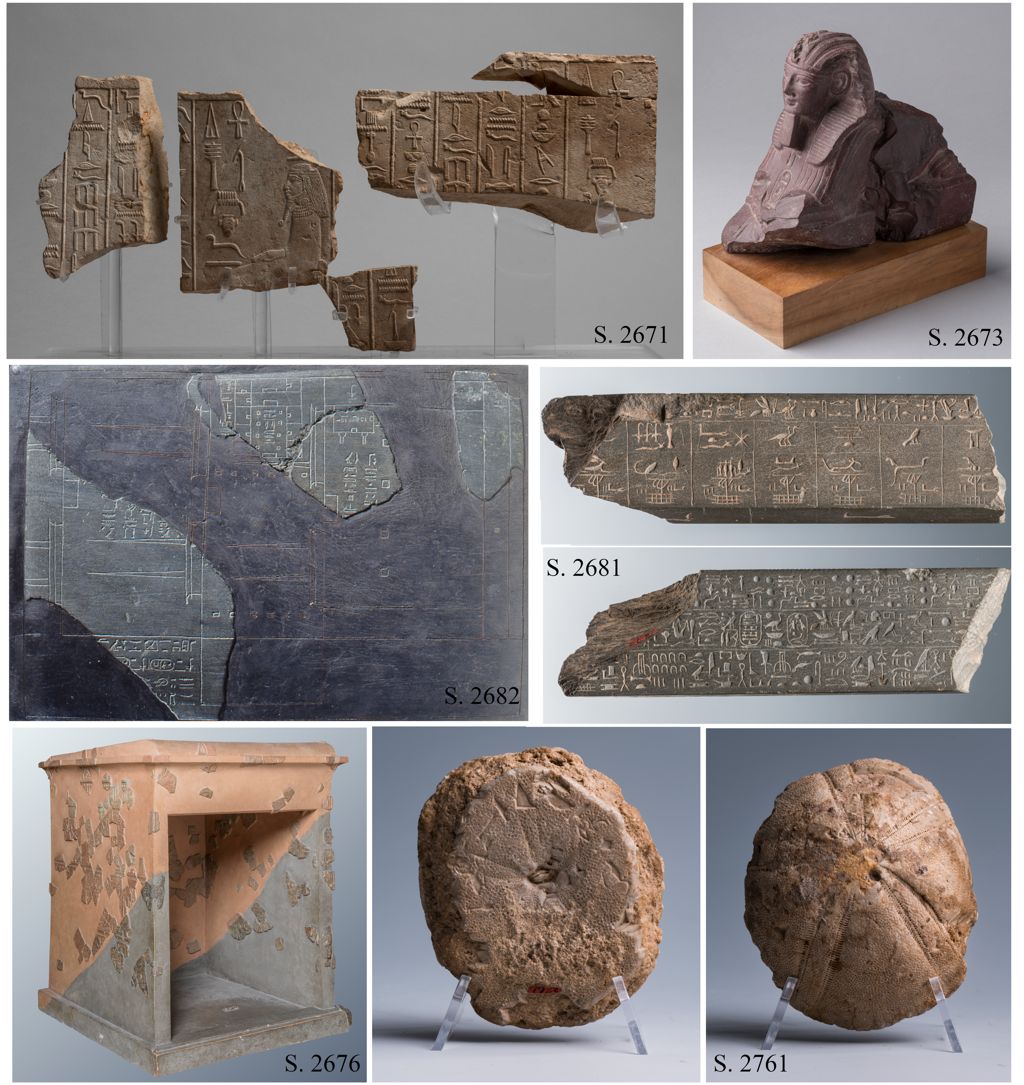
Fig. 8
Once the outstanding nature of many of the “buca” findings had been acknowledged, Schiaparelli was unsure about how to justify the macroscopic traces of wilful demolition on such precious (and sacred) objects, even if the idea of a “votive” deposit seems to underlie his words:32
Despite the exceptional number and quality of the uncovered artefacts and the efforts made to piece together all the archival information in order to provide a valid re-contextualisation for them,33 the lack of a photographic record of the discovery34 and the then-believed absence35 of archaeological parallels for the monumental mudbrick concentric structure (including its cachettes/votive hoards) has long constituted an obstacle for a complete understanding and re-evaluation of the Italian excavations at Heliopolis.
Moreover, it has long been unclear what the relation was between Schiaparelli’s “tempio” and another mud brick structure that Petrie identified, less than 10 years later during his excavations at Heliopolis, as a “Hyksos Fort”.36
How could one get out of this dead end? It was time to move beyond the comfort zone of the study of the “archival” Heliopolis and start a fruitful dialogue with the present-day City of the Sun.
3. Current excavations (Klara Dietze)
More than a century after Ernesto Schiaparelli and the M.A.I. had been active at the site, in 2012, Aiman Ashmawy (Ministry of Tourism and Antiquities of Egypt in Cairo) and Dietrich Raue (Ägyptisches Museum – Georg Steindorff – der Universität Leipzig) founded the Heliopolis Project: an Egyptian-German mission that conducts archaeological rescue investigations in several areas of the main temple precinct of Heliopolis (modern Matariya).37 Of particular interest for the collation with the Italian excavation is Area 232, which – according to Federica Ugliano’s research – is located ca. 200 m south of the trenches associated with the “tempio del Sole” in the southeastern part of the main temenos (Figs. 9–10). Thanks to the support of the Gerda Henkel Foundation and many additional donors, nine field seasons were carried out in the area between 2015 and 2021.38
Areas of excavation of the Heliopolis Project (Photo: Google Earth). © i3mainz.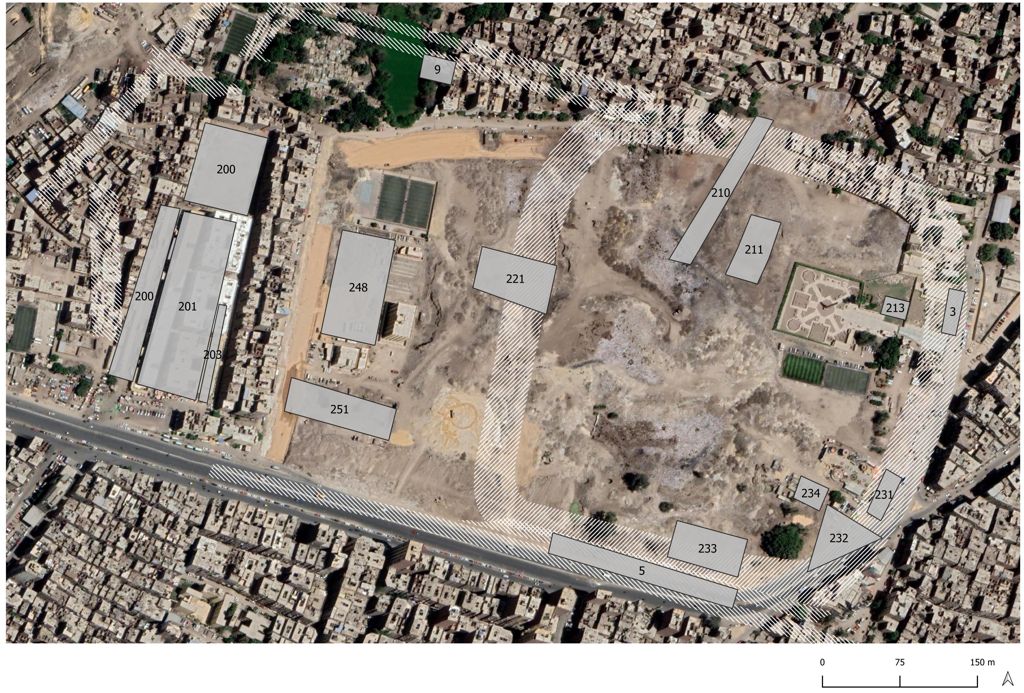
Fig. 9
Overview of the economic precinct of the 7th–2nd century BC encroaching on the inner facade of the embankment of Thutmosis III in Area 232, view to the northwest (Photo: Klara Dietze). © Heliopolis Project.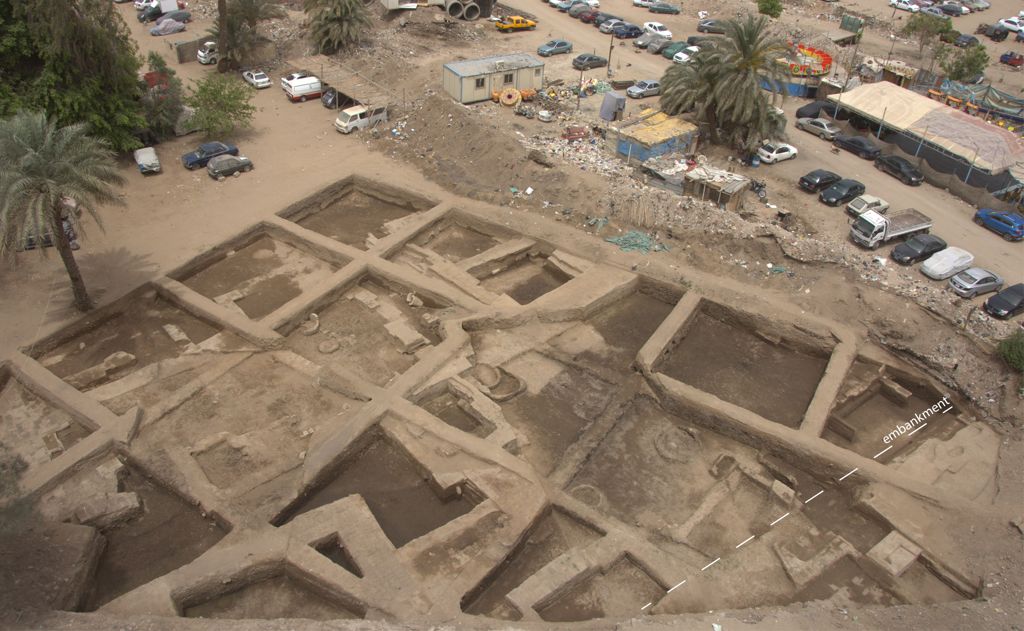
Fig. 10
Area 232 is located along the inner facade of a massive mudbrick embankment (Figs. 11–12) that is most likely to be identified with the “massive vault” described by Schiaparelli as well as Petrie’s “Hyksos fort/Fort bank” (see below). According to recent studies, it was probably built around the main temple site in the 5th regnal decade of Thutmosis III to lessen the threat of flood waters.39 During its excavation in Area 232, a limestone threshold was found in situ and identified as one of the original gates to the main temenos of the 18th Dynasty. Moreover, the excavations at the gate confirmed the existence of an inner sand core, already described by Petrie.40
The mudbrick embankment of Thutmosis III in Area 232 (digital drawing: Klara Dietze). © Heliopolis Project.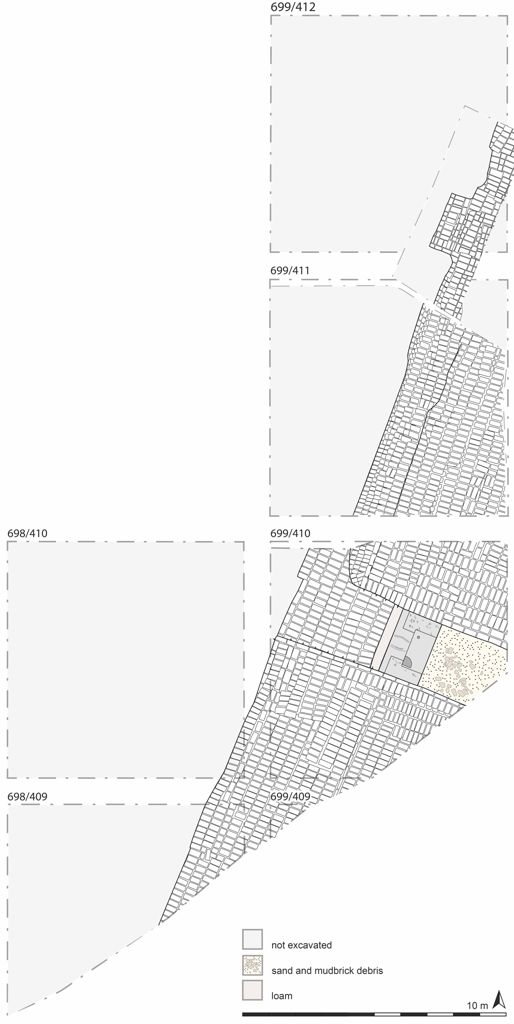
Fig. 11
Detail of the mudbrick embankment of Thutmosis III in Area 232 (photo: Klara Dietze). © Heliopolis Project.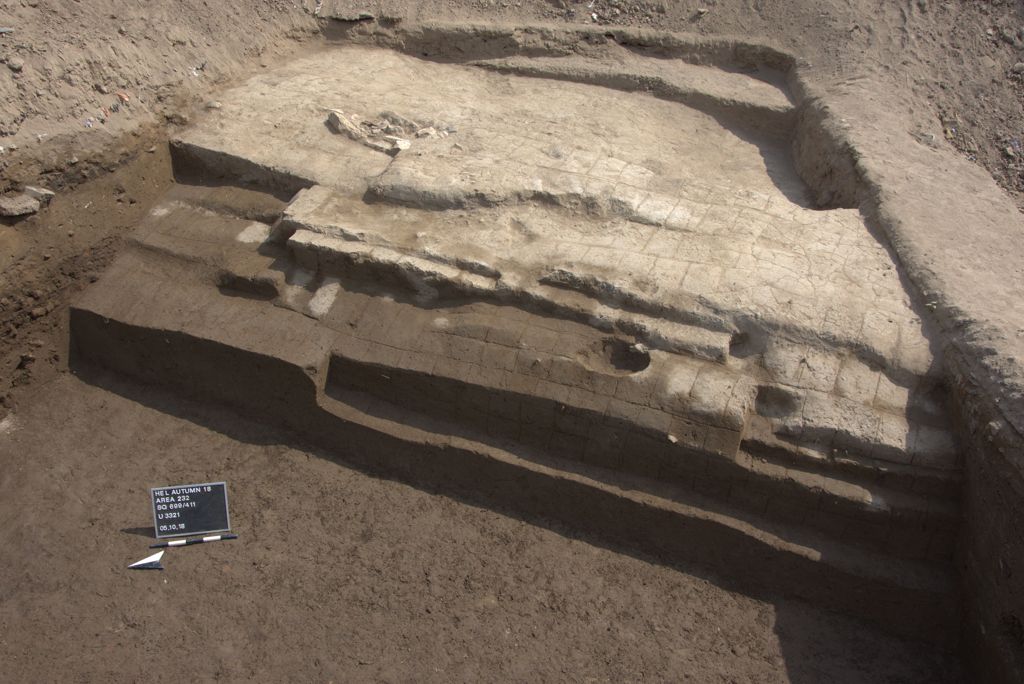
Fig. 12
Inside the enclosed area, the site revealed housing structures and economic workshops predominantly dating to the 7th–2nd century BC. The earliest strata above groundwater date back to the late Ramesside period. Along the inner facade of the embankment, a deposit – most likely dating from the 20th–22nd Dynasty – was documented. It comprised more than a hundred wilfully demolished cult objects, among
Selection of objects from the deposit of the 20th–22nd Dynasty, along the inner facade of the embankment of Thutmosis III in Area 232 (photo: Klara Dietze). © Heliopolis Project.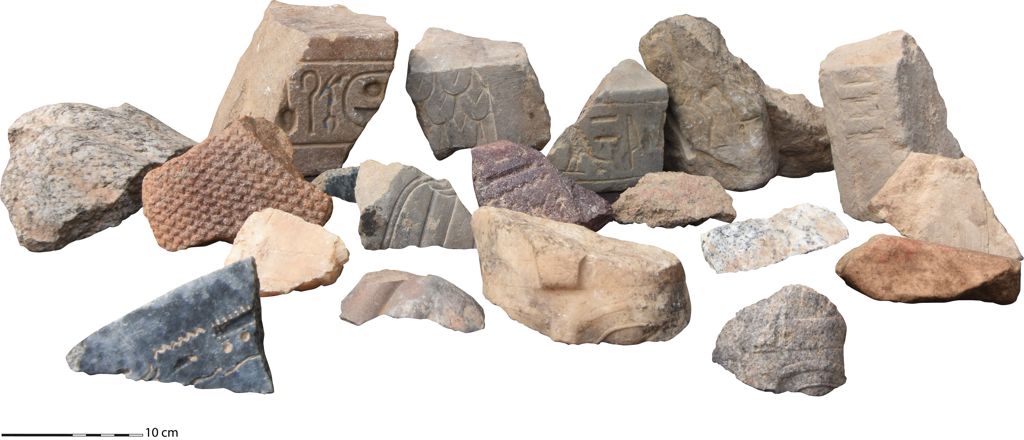
Fig. 13
During the early Late Period (7th–5th century BC), the site was dominated by the workshops of the temple economy, which probably served the cult processes and sacrificial offerings in the main temenos. Bread, in particular, was produced in kitchens equipped with rows of pottery kilns. Functionally related to the bakeries was a slaughterhouse, the waste of which has been archaeologically attested in the area.42 A large number of bones have been found, almost exclusively of young cattle and bearing butchery marks. These were uncovered in a dumping site consisting of broad black ash layers mixed with pottery rubble that contributed to the corpus of trays and cups characterizing the Late Period strata of the precinct.
Furthermore, a votive deposit was discovered during the dismantling of a mudbrick housing structure of the late 26th/early 27th Dynasty, built against and later encroaching on the inner facade of the embankment (Fig. 14). The deposit – contained in a small cavity inside the masonry – was filled with precious finds, including five metal ingots, a limestone tablet with the canonical grid lines, a fragment of what may be a flute or a reed instrument,43 a fragment of a Hathor sistrum of faience, several fragments of New Year flasks, and amulets, beads and shells (Fig. 15). Another votive deposit was located on the outside of the same housing structure. This was inside a pit and also contained a wide range of objects, among which two small metal statuettes of child-gods stand out.
Architectural setting of the votive deposit of the late 26th/early 27th Dynasty inside the mudbrick masonry of a housing structure in Area 232 (Photo: Klara Dietze). © Heliopolis Project.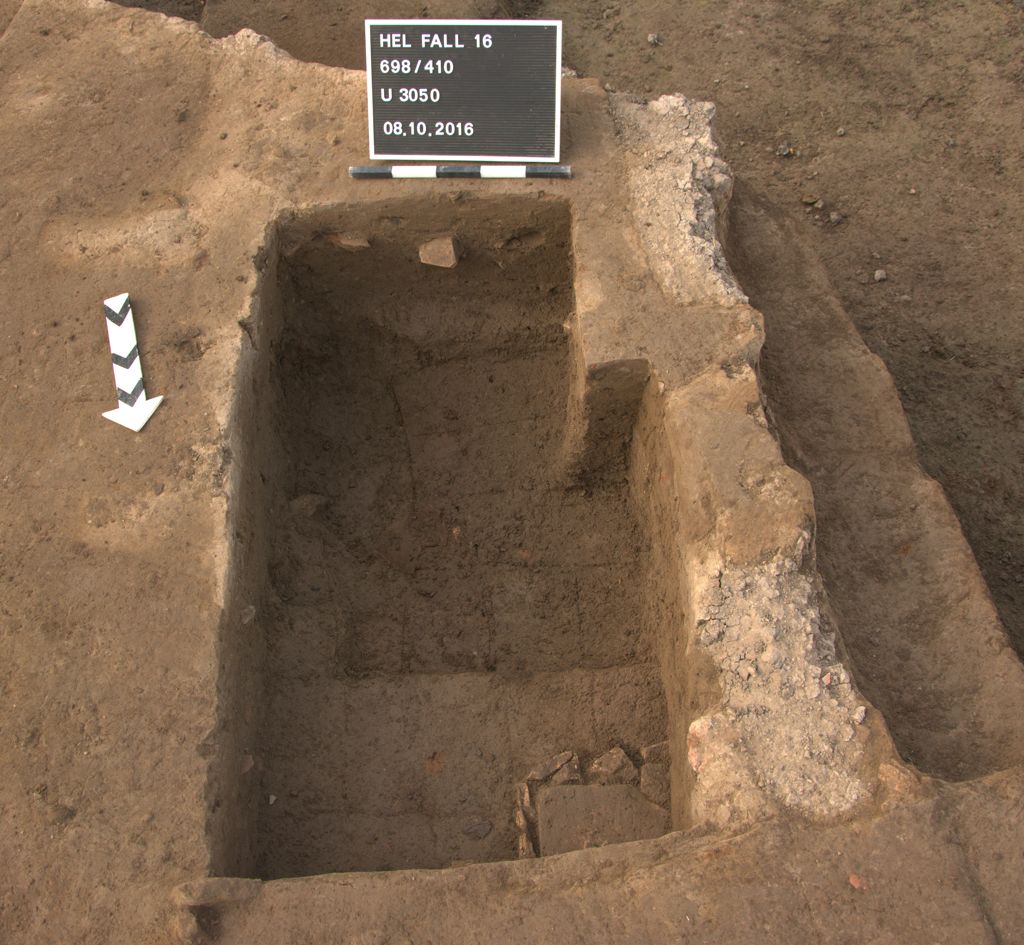
Fig. 14
Selection of objects from the votive deposit of the late 26th/early 27th Dynasty inside the mudbrick masonry of a housing structure in Area 232 (photo: Klara Dietze). © Heliopolis Project.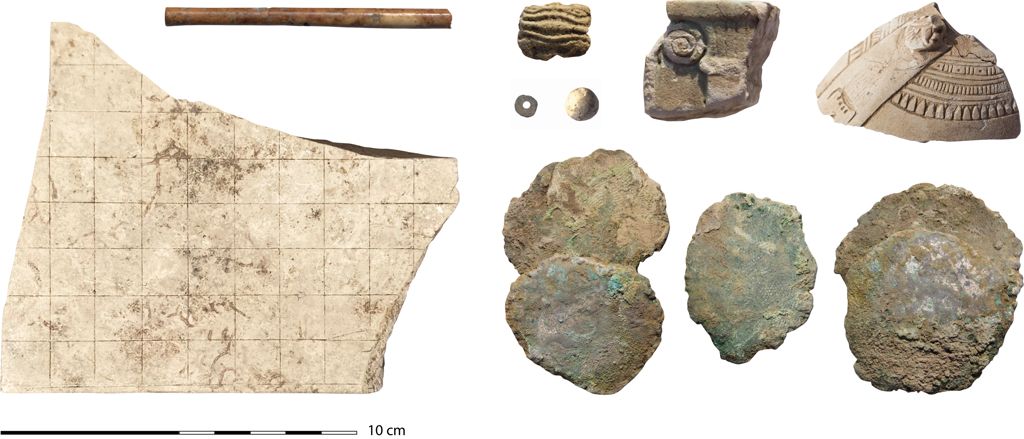
Fig. 15
Large parts of the former economic structures were in use until the Early and Mid-Ptolemaic time (3rd–2nd century BC). Intensive use of the kilns in the kitchens indicates that the site’s main focus remained the production of bread. While the economic activities of the Late Period were most likely associated with the Saite renaissance of the Heliopolitan temple (initiated by Psamtik I), the cult activity in the main temenos had probably already lain fallow under the Ptolemies. The food production in Area 232 in that period was thus very likely for the benefit of a different group of people, whose identity remains to be determined.
4. A dialogue of past and present excavations (Klara Dietze)
By comparing the accounts on the “tempio del Sole” with the results from Area 232, several similarities are striking. In the following, the four main correspondences of these excavations will be summarized, explained and interpreted.
4.1. Comparison of the “tempio del Sole” with the 18th Dynasty embankment in Area 232
In the “tempio del Sole”, Schiaparelli claims to have observed “[…] un edificio di forma circolare o, più esattamente, un segmento di circolo […]” with a diameter of about 600 m and 40 m wide walls, which, as he thought, must be identified as a temple itself.44 The structure can most likely be identified with the 18th Dynasty mudbrick embankment part of which was detected in Area 232 and the neighbouring Area 231 (Fig. 9),45 first and foremost because the relocation of the relevant trenches of the M.A.I. as well as the plan published by Petrie both indicate that the structure ran through both areas, and because the descriptions of certain structural details, such as solidity and the existence of an inner sand core, are consistent. However, the supposedly internal features of the structure strongly confused Schiaparelli: he gave an account of several narrow mudbrick walls, vaults, pillars and small inner chambers built contemporaneously to the embankment.46 Judging by the results from Area 232, these features are likely to correlate either to:
- a) the inner sand core of the embankment and/or possibly inner retaining walls,
- b) or more recent housing structures from the Late Period built onto the embankment, but perhaps not recognized as such in 1903 and thought to belong instead to the original structure.
Thus far, the current excavations have yielded no indications of an architecturally designed internal structure of the embankment as postulated by Schiaparelli. With regard to this, it can be assumed that the embankment served as a particularly strong enclosure wall rather than as a temple, as Schiaparelli thought.
4.2. Comparison of the “buca” with the votive deposits in Area 232
The account of the “buca” does not seem too unusual in the light of the several deposits documented in Area 232; not least because these may all be associated with the Thutmoside embankment as an instance of sacred liminality.47 The aforementioned deposit in the walls of a housing structure of the 26th/27th Dynasty, leaning against and encroaching on the embankment facade, was created as a cavity in the mudbrick masonry (Fig. 14–15). Thus, it is conceivable that the “buca” might also have been a cavity in the masonry of a more recent building erected along and/or over the embankment, a building which, however, was not recognized as such. Otherwise, it could also have been a votive pit (as are also attested in Area 232) dug from above into the masonry of the embankment – and, again, not recognized as such. That the “buca” must have been a more recent deposit, despite all uncertainties, results from the chronological difference between the postulated dating of the embankment to the 18th Dynasty and the cubit of Shoshenq I, which is the most recent certainly dated object from the “buca”48 and offers a terminus ad/post quem for the deposition.49
The location of the deposit(s) within the sacred precinct suggests that they probably served as the ritual burial place for the objects in them. It is noticeable that, except for the fossilized sea urchin, the “buca” was mainly filled with royal donations (e.g. the naos fragments of Djoser and Sethi I), whereas, for example, the deposit in the masonry of the Late Period housing structure in Area 232 probably exclusively held private offerings (e.g. the metal ingots50).
Yet another observation is striking: while the majority of the objects from the “buca” display traces of wilful demolition, being “[..] ridotti in minuti frammenti ed in scheggie informi”,51 the objects from the masonry deposit appear to be generally unharmed. However, the deposit of the 20th–22nd Dynasty from the inner side of the embankment in Area 232 comprised more than one hundred tiny fragments, the majority of which originate from royal donations to the main temple and could certainly be described as “[..] ridotti in minuti frammenti ed in scheggie informi”.
4.3. Comparison of the findings of destroyed temple inventories
Probably the most crucial feature of both excavations are the large amounts of demolished temple inventory, which – in case of the Italian investigations – was mainly found in the “buca”. The fact that the finds were subjected to deliberate destruction (“[…] colla evidente intenzione di distruggerli […]”) is proven by the dimensions of the fragments, which suggest that the objects were systematically smashed into small pieces, as well as by the traces of fire that can be detected on most of the fragments. As mentioned before, it is particularly the deposit from the inner side of the embankment in Area 232 that included a large amount of demolished temple inventory, mainly temple reliefs and royal statuary from the New Kingdom. Furthermore, the majority of the limestone relief fragments from the deposit were heavily burnt. The analysis of pottery sherds from the context suggests that the objects were deposited in the late Ramesside period or early Third Intermediate Period. The record of the deposit matches with occasional observations from preceding seasons when several valuable objects were found scattered around the site, among them fragments of naoi, royal statues and large sphinxes, and private votive stelae. The object categories, the sizes of the fragments and the traces of fire crucially link them to the features from 1903. So far, it is unclear what process led to the fragmentation of the objects. Whether the objects were purposely (ritually?) smashed for deposition or fell victim to a violent attack and were only later deposited is the subject of ongoing research.
4.4. Comparison of pottery types and stratigraphy
In his excavation journal, Ballerini sketched the two main types of pottery that the Italian Mission came across in the south-eastern part of Heliopolis, in what they called the “trincee a meridione” (Fig. 16), probably located only 30 m east of Area 232.52 The drawings can easily be identified as representing the two main types from Area 232: trays of rough fabric and mastoid drinking cups from the Late Period strata (Fig. 17).53 Similarly to the recent excavations, the M.A.I. found the majority of the sherds in extensive ash layers probably originating from large-scale industrial processes.
Entry in the journal of Francesco Ballerini with sketches of ceramic trays and cups from the “trincee a meridione“ (southern trenches), dated to 12 April 1904. © Archivio di Stato, Torino, Fondo MAE, Terzo Versamento.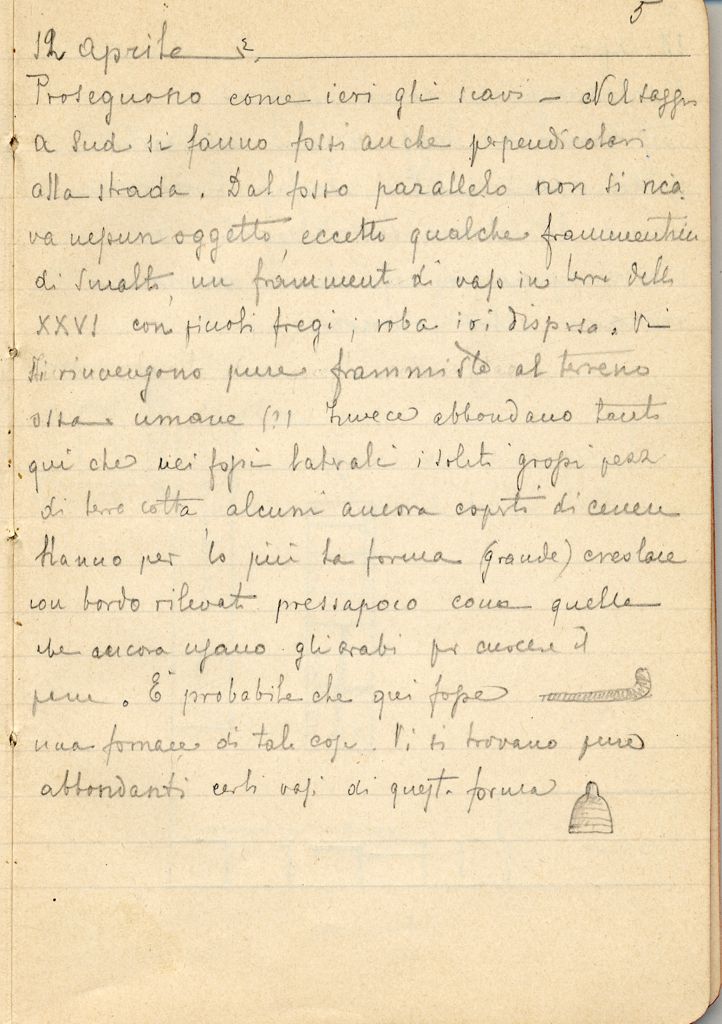
Fig. 16
Selection of ceramic trays and cups from the Late Period strata in Area 232 (drawings: Pieter Collet, Anne Herzberg-Beiersdorf, Nora Shalaby). © Heliopolis Project.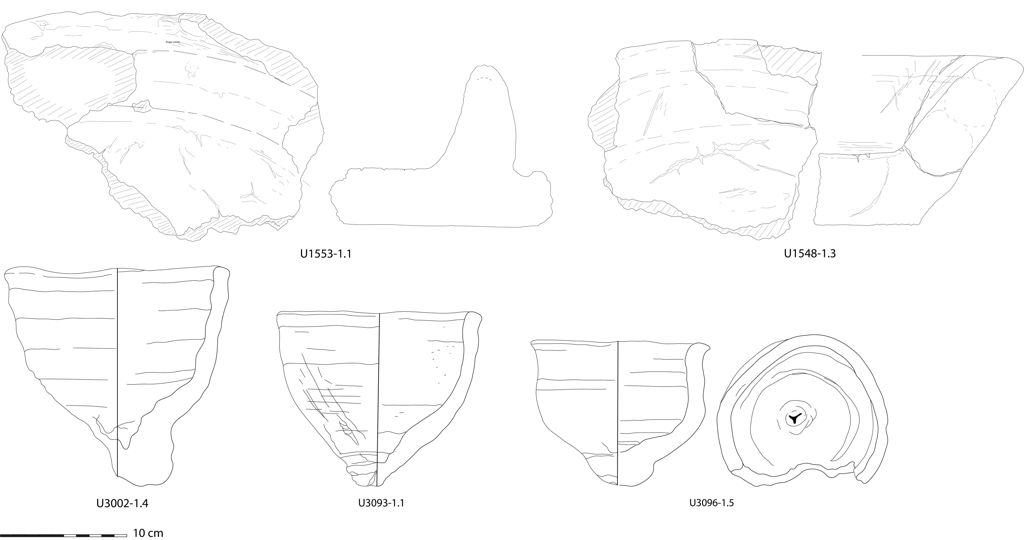
Fig. 17
These matching excavation results indicate that the “tempio del Sole” can most likely be identified as an archaeological context that is connected stratigraphically, chronologically and in terms of its original functionality to the results from Area 232. The find corpora, in particular, seem to allow the interpretation of both sites as belonging to the same economic precinct of the Late Period. In view of the recent excavations, it seems probable that Schiaparelli misunderstood different usage strata, which – as in Area 232 – most likely encompassed more than 1000 years. He assumed the architectural features to be contemporary and belonging to one and the same “circular building”. This explains why a complete understanding of the structure and the archaeological find circumstances of the famous objects from the “buca” has been prevented thus far. However, a large part of the archaeological context of the “tempio del Sole” and its deposit might be reconstructed by comparing it with the results from Area 232.
5. Conclusion (Federica Ugliano)
Though still too often overlooked, archives are increasingly being recognised as powerful instruments for a reconsideration not only of the history of Egyptology as a discipline, or of the birth account of many museum collections, but also and especially for the study of sites excavated in past and present times.54
But in order to overcome the intrinsic limits of any archival source,55 it is fundamental to go beyond the aesthetics of self-referential archival study and constantly move back and forth between the old records and the field, as new archaeological standards can compensate for the lack, loss and bias of past practices.
As clearly demonstrated by the proposed case-study, the dialogue between archives, past and current excavations, museum collections and newly discovered artefacts has not only contributed significantly to a better understanding of the archaeological topography and historical development of one of the most significant sites of Egyptian history, but also allows for a re-interpretation of old data and provides highly important objects in the Museo Egizio with a probable archaeological context.
In our case, the dialogue between past and present fieldwork was decisive to clear many interpretative hurdles, which could not be overcome without constantly moving back and forth between the archive and the field. It also presented us with the opportunity to check and test assumptions made on a theoretical level against actual archaeological results.
6. Acknowledgments
We would like to express our gratitude to Christian Greco, the Museo Egizio staff, to Marilina Betrò and the Università di Pisa (Dipartimento di Civiltà e Forme del Sapere) for financial support, and to the Archivio di Stato di Torino, the SAPAB-TO (Torino), the Archivio Centrale (Roma) and the Istituto Veneto di Scienze, Lettere ed Arti (Venezia) for permission to access the unpublished archival material related to the M.A.I excavations.
Furthermore, we are deeply indebted to Aiman Ashmawy and Dietrich Raue for their support in the research and their permission to publish the results. Equally, we would like to thank Khaled Abou el-Ella and Hoda Ahmed Kamal for their continued support of our work in the field and beyond, the other team members from Egypt and many other countries, as well as Rais El-Amir Kamil Saddiq and Rais Ashraf El-Amir, and the workmen from Quft and Matariya/Arab el-Hisn.
Finally, sincere thanks are due to the Gerda Henkel Foundation, which provided substantial support for the research project on the findings in Area 232.
Bibliography
Abd el-Fattah, A. and P. Gallo, “Aegyptiaca Alexandrina. Monuments pharaoniques découverts récemment à Alexandrie”, in: J.-Y. Empereur (ed.), Alexandrina I (Études alexandrines 1), Le Caire 1998, pp. 7–19.
Abd el-Gelil, M., Shaker, M. and D. Raue, “Recent Excavations at Heliopolis”, Or 65/2 (1996), pp. 136–46.
Allen, J.P., Genesis in Egypt: The Philosophy of Ancient Egyptian Creation Accounts (Yale Egyptological Studies 2), New Haven 1988.
Ashmawy, A.A., M. Beiersdorf, M. de Dapper, T. Herbich, and D. Raue, Report on the Work of the Egyptian-German Mission at Matariya/Heliopolis in Spring 2014, via: https://www.dainst.org/forschung/projekte/noslug/5724?tx_wfdaiprojects_projects%5Bnav%5D=open&tx_wfdaiprojects_projects%5Bsection%5D=results&cHash=c5bacb961e0c52001e097819eb71e24a.
Ashmawy, A.A., M. Beiersdorf, and D. Raue, “The Thirtieth Dynasty in the Temple of Heliopolis”, EgArch 47 (2015), pp. 13–16.
Ashmawy, A.A., M. Beiersdorf, and D. Raue, Report on the Work of the Egyptian-German Mission at Matariya/Heliopolis in Spring 2015, via: https://www.dainst.org/forschung/projekte/noslug/5724?tx_wfdaiprojects_projects%5Bnav%5D=open&tx_wfdaiprojects_projects%5Bsection%5D=results&cHash=c5bacb961e0c52001e097819eb71e24a.
Ashmawy, A.A., C. Breninek, K. Dietze, T. Graichen, D. Raue, and S. Schulz, Report on the Work of the Egyptian-German Mission at Matariya/Heliopolis in Autumn 2015 and Spring 2016, via: https://www.dainst.org/forschung/projekte/noslug/5724?tx_wfdaiprojects_projects%5Bnav%5D=open&tx_wfdaiprojects_projects%5Bsection%5D=results&cHash=c5bacb961e0c52001e097819eb71e24a.
Ashmawy, A.A., S. Connor, and D. Raue, “Psamtik I in Heliopolis”, EgArch 55 (2019), pp. 34–39.
Barsanti, A., “Fouilles de Zaouiét el-Aryan (1911-1912)”, ASAE 12 (1912), pp. 41–47.
Bickel, S., La cosmogonie égyptienne avant le Nouvel Empire (OBO 134), Fribourg/Göttingen 1994.
Blaschta, S., “The Geographical Procession from the Temple of Nectanebo I in Heliopolis”, in: A.A. Ashmawy, D. Raue and D. von Recklinghausen (eds.), Von Elephantine bis zu den Küsten des Meeres. Die Kulttopographie Ägyptens nach den Gauprozessionen der Spätzeit und der frühptolemäischen Epoche, Soubassementstudien VII (Studien zur spätägyptischen Religion 24), Wiesbaden 2019, pp. 1–70.
Breccia, E., Faraoni senza pace, Napoli 1939.
Bruffaerts, J.-M. and M.-C. Bruwier, “Les fouilles archéologiques belges à Héliopolis. La campagne de 1907 (Jean Capart). La campagne de 1912 (Albert Daninos)”, in: A. Van Loo and M.-C. Bruwier (eds.), Héliopolis, Bruxelles 2010, pp. 35–41.
Calmettes, M.-A., “La religion d’Iounou : cosmogonie et monothéisme originel”, in: M.-C. Bruwier and F. Doyen (eds.), Héliopolis d’Égypte – La Ville Du Soleil. Le catalogue publié à l’occasion de l’Exposition, Bruxelles 2019, pp. 7–18.
Connor, S., and K. Abou Al-Ella, “From Bab el-Nasr to Matariya. A Tale of Two Wandering Sphinxes”, ZÄS 147/2 (2020), pp. 141–52.
Consonni, A., T. Quirino, and A. Sesana (eds.), L’Egitto di Francesco Ballerini. Un egittologo comasco agli inizi del Novecento. Atti della giornata di studi, lettere, fotografie, Como 2012.
Contardi, F., Il Naos di Sethi I da Eliopoli: un monumento per il culto del dio Sole (CGT 7002) (Catalogo del Museo Egizio di Torino, Serie Prima – Monumenti e Testi), Milano 2009.
Curto, S., “I siti regali: Eliopoli e Giza”, in: A.M. Donadoni Roveri (ed.), Civiltà degli Egizi. Le credenze religiose, Milano 1988, pp. 44–61.
Curto, S., Storia del Museo Egizio di Torino, Torino 19903.
De Dapper, M. and T. Herbich, “Geomorphological and Geophysical Survey”, EgArch 46 (2015), pp. 12–13.
de Sacy, M.S., Relation de l’Égypte, par Abd-Allatif, médecin arabe de Bagdad, traduit et enrichi de notes historiques et critiques, Paris 1810.
Del Vesco, P. and B. Moiso (eds.), Missione Egitto 1903–1920: L’avventura archeologica M.A.I. raccontata (catalogo della mostra, Torino, Museo Egizio, 11 marzo-10 settembre 2017), Torino – Modena 2017.
Del Vesco, P. and F. Ugliano, “Le ricerche a Giza e a Eliopoli”, in: P. Del Vesco and B. Moiso (eds.), Missione Egitto 1903–1920: L’avventura archeologica M.A.I. raccontata (catalogo della mostra, Torino, Museo Egizio, 11 marzo-10 settembre 2017), Torino – Modena 2017, pp. 223–39.
Deotto, G., “L’Università di Padova in Egitto. Analisi e ricostruzione dello scavo a Tebtynis attraverso la documentazione inedita” (tesi di dottorato, Università degli Studi di Padova), Padova 2015.
Dietze, K., “Das Korpus der Mauerstelen Thutmosis‘ III. und die innere Umfassungsmauer im Tempel von Heliopolis”, in: A.A. Ashmawy, K. Dietze and D. Raue (eds.), Heliopolis – Kultzentrum unter Kairo, Kleine Schriften im Auftrag des Ägyptischen Museums – Georg Steindorff – der Universität Leipzig, Leipzig 2020, pp. 37–56.
Donadoni Roveri, A.M., “Storia del Museo Egizio di Torino”, in: A.M. Donadoni Roveri, E. Leospo, E. D’Amicone, A. Roccati, and S. Donadoni (eds.), Il Museo Egizio di Torino. Guida alla lettura di una civiltà, Novara 1988, pp. 8–57.
Donadoni Roveri, A.M. (ed.), Dal Museo al Museo. Passato e Futuro del Museo Egizio di Torino, Torino 1989.
Donadoni Roveri, A.M. and F. Tiradritti (eds.), Kemet: alle sorgenti del tempo. L’Antico Egitto dalla preistoria alle piramidi (catalogo della mostra, Ravenna, 1 marzo-28 giugno 1998), Milano 1998.
Duranti, L., “Il documento archivistico”, in: L. Giuva and M. Guercio (eds.), Archivistica. Teorie, metodi, pratiche, Roma 2004.
El-Banna, E.S., Le voyage à Héliopolis. Description des vestiges pharaonique et des traditions associées depuis Hérodote jusqu’à l’expédition d’Egypte (Recherches d’archéologie, de philologie et d’histoire 36), Le Caire 2014.
Fiore Marochetti, E., “Epigrafi regali dalle aree dei templi a Eliopoli e Gebelein”, in: E.M. Ciampini and P. Zanovello (eds.), Antichità egizie e Italia. Prospettive di ricerca e indagini sul campo. Atti del III Convegno Nazionale Veneto di Egittologia Ricerche sull’antico Egitto in Italia (Antichistica 6; StudOr 2), Venezia 2014, pp. 77–84.
Gabolde, L. and D. Laisney, “L’orientation du temple d’Héliopolis : données géophysiques et implications historiques”, MDAIK 73 (2017), pp. 105–32.
Heiden, D., “Pharaonische Baumaterialien in der mittelalterlichen Stadtbefestigung von Kairo”, MDAIK 58 (2002), pp. 257–75.
Ikram, S., “Collecting and Repatriating Egypt’s Past: Toward a New Nationalism”, in: H. Silverman (ed.), Contested Cultural Heritage. Religion, Nationalism, Erasure, and Exclusion in a Global World, London 2011, pp. 141–54.
Jarsaillon, C., “Schiaparelli et les archéologues italiens aux bords du Nil : égyptologie et rivalités diplomatiques entre 1822 et 1922”, RiME 1 (2017), pp. 1–21.
Jarsaillon, C. and P. Del Vesco, “L’archeologia in Egitto tra la fine dell’Ottocento e l’inizio del Novecento”, in: P. Del Vesco and B. Moiso (eds.), Missione Egitto 1903–1920: L’avventura archeologica M.A.I. raccontata (catalogo della mostra, Torino, Museo Egizio, 11 marzo – 10 settembre 2017), Torino – Modena 2017, pp. 119–31.
Jeffreys, D., “Joseph Hekekyan at Heliopolis”, in A. Leahy and W.J. Tait (eds.), Studies on Ancient Egypt in Honour of H.S. Smith, London 1999, pp. 157–68.
Kahl, J., A.M. Sbriglio, P. Del Vesco, and M. Trapani (eds.), Asyut. The Excavations of the Italian Archaeological Mission (1906–1913) (Studi del Museo Egizio 1) Modena 2019.
Kákosy, L., “Heliopolis”, LÄ II (1977), cols. 1111–13.
Karlshausen, Ch. and T. De Putter, “Un oursin pour le dieu. L’oursin de Tjanefer (Turin Suppl. 2761)”, RiME 1 (2017), pp. 1–12.
Khater, A., Le régime juridique des fouilles et des antiquités en Égypte (RAPH 12), Le Caire 1960.
Laboury, D., La statuaire de Thoutmosis III : essai d’interprétation d’un portrait royal dans son contexte historique (AegLeod 5), Liège 1998.
Leospo, E., “Eliopoli, la culla di tutti gli dèi”, in: A.M. Donadoni Roveri and F. Tiradritti (eds.), Kemet: alle sorgenti del tempo. L’Antico Egitto dalla preistoria alle piramidi (catalogo della mostra, Ravenna, 1 marzo – 28 giugno 1998), Milano 1998, pp. 125–27.
Ljungkvist, J. and P. Frölund, “Gamla Uppsala – The Emergence of a Centre and a Magnate Complex”, Journal of Archaeology and Ancient History 16 (2015), pp. 3–30.
Löwenborg, D., “Recuperating GIS Data from Excavations. On the Use, or Lack of Use, of Digital Archaeological Information”, in: I. Huvila (ed.), Perspectives to Archaeological Information in the Digital Society, Uppsala 2014, pp. 11–24.
Lyons, H.G., The Cadastral Survey of Egypt 1892–1907, Cairo 1908.
Lyons, H.G., “The Law Relating to Antiquities in Egypt”, JEA 1 (1914), pp. 45–46.
Malek, J., “The Archivist as a Researcher”, in: J. Assmann, E. Dziobek, H. Guksch, and F. Kampp (eds.), Thebanische Beamtennekropolen. Neue Perspektiven archäologischer Forschung, Internationales Symposion Heidelberg 9.–13.6.1993, Heidelberg 1995, pp. 43–48.
Maspero, G., Rapport sur la marche du Service des Antiquités de 1899 à 1910, Le Caire 1912.
Masson, A., “Interpréter le matériel grec et chypriote dans un contexte religieux et thébain : l’exemple du quartier des prêtres de Karnak – des consommateurs égyptiens de produits grecs et chypriotes”, in: G. Gorre, A. Marangou (eds.), La présence grecque dans la vallée de Thèbes, Rennes 2016, pp. 25–43.
Moiso, B., “Le campagne di scavo di Ernesto Schiaparelli in Egitto dal 1903 al 1920”, in: B. Moiso (ed.), Ernesto Schiaparelli e la tomba di Kha, Torino 2008, pp. 199–269.
Moiso, B., La storia del Museo Egizio, Modena 2016.
Murray, G.W. (ed.), The Survey of Egypt 1898–1948, Cairo 1950.
Müskens, S., Egypt Beyond Representation: Materials and Materiality of Aegyptiaca Romana (Archaeological Studies Leiden University 35), Leiden 2017.
Nuzzolo, M. and J. Krejčí, “Heliopolis and The Solar Cult in The Third Millennium BC”, ÄgLev 27 (2017), pp. 357–79.
Petrie, W.M.F. and E. Mackay, Heliopolis, Kafr Ammar and Shurafa, London 1915.
Raue, D., Heliopolis und das Haus des Re: eine Prosopographie und ein Toponym im Neuen Reich (ADAIK 16), Berlin 1999.
Raue, D., “Religion et politique au cœur de l’ancienne Égypte : le temple d’Héliopolis”, Annuaire de l’École pratique des hautes études (EPHE), Section des sciences religieuses 125 (2018), pp. 93–108. http://journals.openedition.org/asr/1834
Raue, D., Reise zum Ursprung der Welt. Die Ausgrabungen im Tempel von Heliopolis, Darmstadt 2020.
Riggs, C., Photographing Tutankhamon: Archaeology, Ancient Egypt, and the Archive, London 2019.
Roccati, A., “Eliopoli”, in: A.M. Donadoni Roveri (ed.), Dal Museo al Museo. Passato e Futuro del Museo Egizio di Torino, Torino 1989, pp. 166–67.
Saleh, A.-A., Excavations at Heliopolis: Ancient Egyptian Ounû. Vol. I. The Site of Tell el-Ḥiṣn-Maṭarîyah, Cairo 1981.
Saleh, A.-A., Excavations at Heliopolis: Ancient Egyptian Ounû. Vol. II. The Site of Tell el-Ḥiṣn-Maṭarîyah, Cairo 1983.
Sbriglio, A.M., “Gli scavi Schiaparelli a Eliopoli (1903–1906): gli amuleti provenienti dal kom” (tesi di specializzazione, Università degli Studi di Milano), Milano 2014.
Sbriglio, A.M. and F. Ugliano, “Re-excavating Heliopolis: Unpublished Archaeological Data from the Archives of Ernesto Schiaparelli and Missione Archeologica Italiana”, in: M.S. Pinarello, J. Yoo, J. Lundock and C. Walsh (eds.), Current Research in Egyptology 2014. Proceedings of the Fifteenth Annual Symposium. University College London and King’s College London (April 9–12, 2014), Oxford-Philadelphia 2015, pp. 278–93
Schiaparelli, E., “Missione Archeologica Italiana in Egitto sotto gli auspici di Sua Maestà il Re Vittorio Emanuele III. Prima relazione gennaio–maggio 1903” (Biblioteca Reale di Torino), Torino 1903.
Schiaparelli, E. and F. Ballerini, “Missione Archeologica Italiana in Egitto, Seconda Relazione 1904” (Biblioteca Reale di Torino), Torino 1904.
Schiaparelli, E., “Eliopoli. Abbozzo Relazione” (Istituto Veneto di Scienze, Lettere ed Arti), [Torino] [1928].
Sheehan, P., Babylon of Egypt. The Archaeology of Old Cairo and the Origins of the City, Cairo-New York, 2010.
Stevenson, A., “Between the Field and the Museum: The Ongoing Project of Archaeological Context”, Egyptian & Egyptological Documents, Archives & Libraries 4 (2013), pp. 109–18.
Stevenson, A., “Artefacts of Excavations. The British Museum Collection and Distribution of Egyptian Finds to Museums, 1880–1915”, Journal of the History of Collections 26/1 (2014), pp. 89–102.
Stevenson, A., “Egyptian Archaeology and the Museum”, in: C. Gosden (ed.), Oxford Handbooks Online, Oxford 2015.
Stevenson, A., Scattered Finds. Archaeology, Egyptology and Museums, London 2019.
Stevenson, A., Libonati, E. and A. Williams, “A Selection of Minor Antiquities: A Multi-Sited View on Collections from Excavations in Egypt”, WorldArch 48/2 (2016), pp. 282–95.
Thomas, R.I. and A. Villing, “Naukratis Revisited 2012: Integrating New Fieldwork and Old Research”, BMSAES 20 (2013), pp. 81–125.
Ugliano, F., “La collezione predinastica del Museo Egizio di Torino: uno studio integrato di archivi e reperti” (tesi di dottorato, Università degli Studi di Trento), Trento 2016.
Ugliano, F., “Ernesto Schiaparelli and the Italian Archaeological Mission (MAI): Predynastic Egypt at Museo delle Antichità Egizie (Turin, Italy)”, in: B. Midant-Reynes and Y. Tristant (eds.), Egypt at Its Origins 5. Cairo 13th–18th April 2014, Leuven 2017, pp. 199–210.
Webb, V., “Three Faience Rosette Discs in the Museo Egizio in Turin: The Early Ramesside Pharaohs in the Eastern Delta, and Their Glittering Palaces”, RiME 1 (2017), pp. 1–21.
Weill, R., “Monuments nouveaux des premières dynasties”, Sphinx 15 (1911), pp. 1–35.
Yoyotte, J., “Pharaonica”, in: F. Goddio (ed.), Alexandria: The Submerged Royal Quarters, London 1998, pp. 199–244.
Notes
- For a historical overview of the site, see Kákosy, <i>LÄ</i> II (1977), cols. 1111–13; Raue, <i>Heliopolis und das Haus des Re</i>, 1999 and related bibliography; Saleh, <i>Excavations at Heliopolis</i>, I, 1981; Curto, in Donadoni Roveri (ed.), <i>Civiltà degli Egizi. Le credenze religiose</i>, 1988. For discussions and texts related to the Egyptian cosmogony, see Allen, <i>Genesis in Egypt</i>, 1988, pp. 8–35; Bickel, <i>La cosmogonie égyptienne</i>, 1994, pp. 33–80; Calmettes, in Bruwier and Doyen (eds.), <i>Heliopolis</i>, 2019; Raue, <i>Annuaire de l'École pratique des hautes études</i> 125 (2018); Raue, <i>Reise zum Ursprung der Welt</i>, 2020, pp. 23–36.↑
- Strabo, who visited the city in the 1<sup>st</sup> century B.C., already bears witness to the state of total neglect and the destruction of its monumental buildings; see El-Banna, <i>Le voyage à Héliopolis</i>, 2014, pp. 14–17. See also Abd el Fattah and Gallo, in Empereur (ed.), <i>Alexandrina I</i>, 1998; Yoyotte, in Goddio (ed.), <i>Alexandria</i>, 1998; Müskens, <i>Egypt Beyond Representation</i>, 2017.↑
- Connor and Abou Al-Ella, <i>ZÄS</i> 147/2 (2020); Heiden, <i>MDAIK</i> 58 (2002); Leospo, in Donadoni Roveri and Tiradritti (eds.), <i>Kemet</i>, 1998, p. 125; Saleh, <i>Excavations at Heliopolis</i>, I, 1981, pp. 39–41. As very little information regarding Heliopolitan material reused in major Roman period buildings of the “Old Cairo/Babylon of Egypt” area is available, further research into pre-10<sup>th</sup>-century reuse of pharaonic <i>spolia</i> has great potential to shed light on this phenomenon. See, for example: Sheehan, <i>Babylon of Egypt</i>, 2010, p. 65 (fig. 30), note 62 on p. 146, note 68 on p. 148.↑
- For a summary of the first western documentary sources, see Gabolde and Laisney, <i>MDAIK</i> 73 (2017), pp. 107–09, and related bibliography. The City of the Sun was never forgotten by Arab scholars and travellers; see, for example, de Sacy, <i>Relation de l’Égypte, par Abd-Allatif</i>, 1810, pp. 180–81, 225–29 and notes. ↑
- Abd el-Gelil et al., Or 65 (1996); Jeffreys, in Leahy and Tait (eds.), <i>Studies on Ancient Egypt in Honour of H.S. Smith</i>, 1999, pp. 157–68; Raue, <i>Heliopolis und das Haus des Re</i>, 1999, pp. 465–85; Saleh, <i>Excavations at Heliopolis</i>, I, 1981; Saleh, <i>Excavations at Heliopolis</i>, II, 1983; for an account of the more recent excavations, see infra note 37.↑
- Curto, in Donadoni Roveri (ed.), <i>Civiltà degli Egizi. Le credenze religiose</i>, 1988; Curto, <i>Storia del Museo Egizio di Torino</i>, 1990<sup>3</sup>, pp. 53–57, 107–12; Del Vesco and Ugliano, in Del Vesco and Moiso (eds.), <i>Missione Egitto</i>, 2017, pp. 230–32; Donadoni Roveri, in Donadoni Roveri et al. (eds.), <i>Il Museo Egizio di Torino</i>, 1988, pp. 39–40; Leospo, in Donadoni Roveri and Tiradritti (eds.), <i>Kemet</i>, 1998; Moiso, in Moiso (ed.), <i>Ernesto Schiaparelli e la tomba di Kha</i>, 2008, pp. 201–03, 210, 212–13, 222, 228; Moiso, <i>La storia del Museo Egizio</i>, 2016, p. 88; Roccati, in Donadoni Roveri (ed.), <i>Dal Museo al Museo</i>, 1989; Sbriglio and Ugliano, in Pinarello et al. (eds.), <i>Current Research in Egyptology</i>, 2015; Ugliano, “La collezione predinastica”, 2016, pp. 103–40; Ugliano, in Midant-Reynes and Tristant (eds.), <i>Egypt at Its Origins</i> 5, 2017, pp. 203–05; Ugliano, <i>in preparation</i>.↑
- Letter from Schiaparelli to Emilio Ponzio Vaglia, Minister of the Royal House, 12/06/1902 (Torino, Archivio di Stato, Fondo MAE, Secondo Versamento, Primo Mazzo, Fascicolo 5): “[…] Però uno simile scavo del tempio presenterebbe non lievi difficoltà, sia per l'espropriazione dei terreni che sono ora di privata proprietà, sia per le spese, certo relativamente notevoli, trattandosi non di rimuovere della sabbia, come negli altri scavi in Egitto, ma creta e blocchi di ingenti dimensioni, fino alla profondità di alcuni metri, e sopra un'area certo assai larga. […] Le Missione archeologiche francesi, tedesca, inglese ecc. preferirono piccoli scavi, da esaurirsi in breve tempo, ed evitarono uno scavo come quello di Eliopoli, che, per dare i risultati che se ne sperano, esige proprio tempo lungo, lavoro, ricerche pazienti, regolari e perseveranti […] But an excavation of the temple area might face many difficulties, for the expropriation of the fields, which are now of private ownership, and for the considerable economical investments, because it is necessary to clear away not just sand, but also clay and massive blocks, until a depth of several metres, along an extensive area. […] The French, German and English archaeological missions preferred smaller excavations, to be completed in less time, and avoided an excavation like ours at Heliopolis, which, to obtain the hoped-for results, requires strenuous efforts, and patient, regular and persevering investigations.” In 1906, Jean Capart, financially supported by the industrialist Édouard Empain, asked Maspero for permission to enter the Italian concession, but was denied his request; see Bruffaerts and Bruwier, in Van Loo and Bruwier (eds.), <i>Héliopolis</i>, 2010, p. 36. For a discussion about the relationship between Maspero and his European colleagues, see also Jarsaillon, <i>RiME</i> 1 (2017), pp. 8–10.↑
- Del Vesco and Moiso (eds.), <i>Missione Egitto</i>, 2017, pp. 136–37 (n. 116, 118).↑
- Schiaparelli and Ballerini, “Missione Archeologica Italiana in Egitto”, 1904, pp. 18–20; De Dapper and Herbich, <i>EgArch</i> 46 (2015); Petrie and Mackay, <i>Heliopolis</i>, 1915, pp. 1, 3.↑
- For a summary account of each of the four campaigns, see Moiso, in Moiso (ed.), <i>Ernesto Schiaparelli e la tomba di Kha</i>, 2008, pp. 201–03, 210, 212–13, 222, 228; Sbriglio and Ugliano, in Pinarello et al. (eds.), <i>Current Research in Egyptology</i>, 2015, pp. 284–92; Ugliano, “La collezione predinastica”, 2016, pp. 103–33; Ugliano, <i>in preparation</i>.↑
- The total of 1550 inventory numbers does not correspond to the total amount of artefacts coming from the M.A.I. excavations at Heliopolis: as demonstrated by the present author’s checking of the inventory and survey in the Museo Egizio storerooms carried out since 2019 with the support of the Museo Egizio Collection Management staff (Sara Aicardi, Valentina Brambilla), a single inventory number may correspond to many fragments or several typologically similar objects. The assessment of the quantitative and qualitative nature of this collection is still ongoing. Many artefacts – e.g. pottery sherds and flint tools unearthed from the so-called “prehistoric village” – have yet to be inventoried and precisely quantified.↑
- Khater, <i>Régime juridique</i>, 1960, pp. 271–73, 275–79; Lyons, <i>JEA</i> 1 (1914). See also Jarsaillon and Del Vesco, in Del Vesco and Moiso (eds.), <i>Missione Egitto</i>, 2017, pp. 126–27; Ikram, in Silverman (ed.), <i>Contested Cultural Heritage</i>, 2011, pp. 142–45; Stevenson, <i>Scattered Finds</i>, 2019, pp. 259–60.↑
- Torino, Archivio di Stato, Fondo MAE, Secondo Versamento, Secondo Mazzo, Fascicolo 2 e 6. The so-called “Manuscript Inventory” is not just a list of objects, as it often provides additional information about clusters of artefacts and their relative “stratigraphical” relations. A preliminary inventorying of the artefacts seems to have been done directly on site or, if at a later time, always in accordance to the place of discovery thanks to accurate notes left inside the storage boxes. Schiaparelli’s interest in understanding and recording the original context of excavated artefacts has already been pointed out by Del Vesco, in Kahl et al. (eds.), <i>Asyut</i>, pp. 64-65, 281-82.↑
- Sbriglio and Ugliano, in Pinarello et al. (eds.), <i>Current Research in Egyptology</i>, 2015, p. 280; Ugliano, “La collezione predinastica”, 2016, pp. 27–28. The only published accounts are short summary descriptions, see Breccia, <i>Faraoni senza pace</i>, 1939, pp. 236–38; Weill, <i>Sphinx</i> 15 (1911), pp. 9–11. In 2017, Giulia Deotto and Paola Zanovello (Università di Padova) kindly reported to the author the presence of a typewritten document among the archival material stored in the Istituto Veneto di Scienze, Lettere ed Arti (Venezia) and related to Carlo Anti’s excavations in Egypt (Deotto, “L’Università di Padova in Egitto”, 2015). After a re-analysis and a complete transcription of the document, the present author identified it as an incomplete draft of the publication of the M.A.I. excavations at Heliopolis, written by Schiaparelli presumably in 1928. Unfortunately, many important data (inventory numbers, photographs, images and plans) were left out. A copy of this document has been recently recovered in the archives of Ernesto Scamuzzi by Beppe Moiso, curator of the Museo Egizio; it will soon be transcribed and compared with the above-mentioned Venetian version (Moiso, personal communication, 2021). This draft, whose full publication is forthcoming, is used as a source in the present article. ↑
- Archivio di Stato di Torino; Museo Egizio; Biblioteca Reale di Torino; Istituto Veneto di Scienze, Lettere ed Arti (Venezia); Archivio Centrale dello Stato (Roma).↑
- Roccati, in Donadoni Roveri (ed.), <i>Dal Museo al Museo</i>, 1989, p. 167.↑
- My search for the documents concerning the Italian excavations at Heliopolis began in 2014, in collaboration with Alice Sbriglio, who in her postgraduate diploma dissertation discussed the amulets found by Schiaparelli in the so-called “<i>kom</i>” area (see Sbriglio, “Gli scavi Schiaparelli a Eliopoli [1903–1906]”, 2014; Sbriglio and Ugliano, in Pinarello et al. [eds.], <i>Current Research in Egyptology</i>, 2015). The research was then carried on by the author as her PhD dissertation, with a focus on the Predynastic evidence (Ugliano, “La collezione predinastica”, 2016; Ugliano, in Midant-Reynes and Tristant [eds.], <i>Egypt at Its Origins 5</i>, 2017). A complete re-analysis of all the archival material and a complete publication of the history of the M.A.I excavations at Heliopolis is forthcoming (Ugliano, <i>in preparation</i>).↑
- The preliminary selection of the documents was not restricted to the excavation records themselves, but included all the information concerning the people involved, the general organisation, the logistics and the administrative paperwork. For this reason, the basic criterion adopted for the selection of the documents was the presence of explicit or implicit reference to the site of Heliopolis/Matariya.↑
- Stevenson, <i>EDAL</i> 4 (2013); Stevenson, in Gosden (ed.), <i>Oxford Handbooks Online</i>, 2015, pp. 5–6.↑
- For the life and work of Francesco Ballerini, see Consonni et al. (eds.), <i>L'Egitto di Francesco Ballerini</i>, 2012.↑
- In our case, the sketches were geo-referenced with QGIS (QGIS.org, 2020. QGIS Geographic Information System. QGIS Association. <a href="http://www.qgis.org">http://www.qgis.org</a>), using control points taken from a 1:5000 cadastral map (sheet n° IV-VII-3) published by the Survey of Egypt in 1917, but compiled from a 1:2500 Cadastral sheet surveyed in 1911–1915, revised in 1912–1915. For a complete account of the work of the “Survey of Egypt” Department, see Murray (ed.), <i>The Survey of Egypt 1898–1948</i>, 1950. For a history of the survey methodology and land classification at the beginning of the 20<sup>th</sup> century, see Lyons, <i>The Cadastral Survey of Egypt 1892–1907</i>, 1908. ↑
- Schiaparelli and Ballerini, “Missione Archeologica Italiana in Egitto”, 1904, pp. 20–23.↑
- For a more detailed list of objects, see also Schiaparelli, “Missione Archeologica Italiana in Egitto”, 1903.↑
- Only in the final draft of the publication did Schiaparelli (“Eliopoli. Abbozzo Relazione”, [1928], pp. 8–9) abandon his original misleading definitions of these cavities as “corridors” (1903) or “crypts” (1904): “[…] Però se i ritrovamenti furono scarsi, sì nell'interno come nell'esterno del nostro edifizio, si ebbe però la fortunata sorpresa di [ritrovare] in una specie di buca scavata nello spessore stesso del voltone, una quantità assai considerevole di frammenti di monumenti e di svariati oggetti votivi che senza dubbio erano stati offerti al tempio.” / “[…] Despite the modest quantity of artefacts unearthed inside and outside our building, we have been fortunate enough to discover, within a kind of hole dug out in the vault thickness, a considerable amount of fragmentary monuments and votive objects which, without any doubt, had been dedicated to the temple.” A 1:100 wooden model of this structure was commissioned by Schiaparelli and it is still at the Museo Egizio (P. 8274). Even if the date of this modern model is difficult to define, it seems to represent the excavated structure according to Schiaparelli’s first interpretation of the cavities as “corridors”. See also Del Vesco e Moiso (eds.), <i>Missione Egitto</i>, 2017, p. 234, n° 199.↑
- Roccati, in Donadoni Roveri (ed.), <i>Dal Museo al Museo</i>, 1989 and related catalogue entries (pp. 168–75). See also Fiore Marochetti, in Ciampini and Zanovello (eds.), <i>Antichità egizie e Italia</i>, 2014, pp. 77–80; Webb, <i>RiME</i> 1 (2017), pp. 3–4, 8–9.↑
- Donadoni Roveri (ed.), <i>Dal Museo al Museo</i>, 1989, p. 170 (n. 3), with further bibliography; Laboury, <i>La statuaire de Thoutmosis III</i>, 1998, pp. 290–91, 688. Curiously, despite the fact that the central part of the sphinx body was missing, the two fragments were restored as joining together.↑
- Contardi, <i>Il Naos di Sethi I</i>, 2009; Donadoni Roveri (ed.), <i>Dal Museo al Museo</i>, 1989, pp. 27–28 (n. 5), with further bibliography.↑
- Donadoni Roveri (ed.), <i>Dal Museo al Museo</i>, 1989, pp. 19–20 (n. 1) and related bibliography; Donadoni Roveri and Tiradritti (eds.), <i>Kemet</i>, 1998, pp. 260–61; see also Nuzzolo and Krejčí, <i>ÄgLev</i> 27 (2017), pp. 357, 361–62.↑
- Del Vesco e Moiso (eds.), <i>Missione Egitto</i>, 2017, pp. 236–37 (n. 202), with further bibliography.↑
- Del Vesco e Moiso (eds.), <i>Missione Egitto</i>, 2017, p. 237 (n. 203); Donadoni Roveri (ed.), <i>Dal Museo al Museo</i>, 1989, p. 168 (n. 1), with further bibliography.↑
- Donadoni Roveri (ed.), <i>Dal Museo al Museo</i>, 1989, pp. 173–74 (n. 12), with further bibliography; Karlshausen and De Putter, <i>RiME</i> 1 (2017).↑
- Schiaparelli, “Eliopoli. Abbozzo Relazione”, [1928], pp. 38–39; in square brackets, the integrations proposed by Carlo Anti to the lacunae left in Schiaparelli’s text.↑
- According to the author’s interpretation of the archival documentation, the most probable location of the “<i>buca</i>” should be the front courtyard of the present Obelisk Open Air Museum (Matariya).↑
- The “<i>buca</i>” was found by Schiaparelli and his Egyptian team, led by the Government assistant rais, Hassanein Dessouki, in 1903 while Ballerini, who was usually in charge of the photographic and field records, was supervising the excavation in Giza, in collaboration with reis Ibrahim Faied. Very little information has been found so far on reis Hassanein, whose name is never cited in the official reports, but only in several documents from the financial section of Schiaparelli’s archive; the choice of hiring Hassanein for Heliopolis (and Ibrahim Faied for Giza) could have been made on the advice of Barsanti, who had worked with them on other excavations. See Barsanti, <i>ASAE</i> 12 (1912), p. 41; Maspero, <i>Rapport</i>, 1912, p. 244.↑
- Contrary to this (still widespread) assumption, the Heliopolitan embankment is not unique, but has a number of parallels in Egypt, especially in the Delta region, as well as beyond. See Dietze, <i>in preparation</i>.↑
- Petrie and Mackay, <i>Heliopolis</i>, 1915, pp. 3–4, pls. I–III.↑
- For general information, see <a href="https://www.dainst.org/forschung/projekte/noslug/5724?tx_wfdaiprojects_projects%5Bnav%5D=open&cHash=3b7aa586f8a97e09771f4a166e878247 ">https://www.dainst.org/forschung/projekte/noslug/5724?tx_wfdaiprojects_projects%5Bnav%5D=open&cHash=3b7aa586f8a97e09771f4a166e878247 </a>. For the results of recent excavations, see Ashmawy et al., <i>Report</i>, 2014; Ashmawy, Beiersdorf and Raue, <i>EgArch</i> 47 (2015); Ashmawy, Beiersdorf and Raue, <i>Report</i>, 2015; Ashmawy et al., <i>Report</i>, 2016; Blaschta in Ashmawy, Raue and von Recklinghausen (eds.), <i>Von Elephantine bis zu den Küsten des Meeres</i>, pp. 1–70; Ashmawy, Connor and Raue, <i>EgArch</i> 55 (2019).↑
- The spectrum of features and finds from Area 232 is the subject of Klara Dietze’s ongoing dissertation, “An economic precinct of the 7<sup>th</sup>-2<sup>nd</sup> century BC at the embankment of Thutmosis III in the temple of Heliopolis (Area 232)”, funded by the Gerda Henkel Foundation (Dietze, <i>in preparation</i>).↑
- On the embankment in the archaeological context of Area 232 and its probable identification with the <named-content content-type="traslitterazione">sbtj n(.j) wmt.t</named-content> of Thutmosis III, see Dietze in Ashmawy, Dietze and Raue (eds.), <i>Heliopolis – Kultzentrum unter Kairo</i>, 2020. The dating of the embankment to the Thutmosis period is further corroborated by the ceramic evidence of sherds taken from the mud bricks in Area 232 and the neighbouring Area 231 (Fig. 9). The latter is located only 20 m north of Area 232 and was shortly investigated by the Egyptian-German mission in spring 2015, when a portion of the same mudbrick embankment was revealed. The ceramics were analyzed by Dietrich Raue (Area 232: Raue, personal communication, 2021; Area 231: see Ashmawy, Beiersdorf and Raue, <i>Report</i>, 2015, pp. 3–4).↑
- Petrie and Mackay, <i>Heliopolis</i>, 1915, pl. II (top).↑
- Stylistic features of both fragments speak for an identification as either Thutmosis III or Amenhotep II (an identification as Hatshepsut is rather improbable due to historical circumstances). We are grateful to Simon Connor for this information.↑
- We would like to thank Louise Bertini (American Research Center in Egypt) and Salima Ikram (American University in Cairo) for the archaeozoological analyses of the bone material. ↑
- A detailed examination of the fragment is still pending.↑
- Petrie (who was rather sure that he investigated the same structure as Schiaparelli only a few years before him) also claimed that its eastern wall measured ca. 40 m in width, Petrie and Mackay, <i>Heliopolis</i>, 1915, pl. II.↑
- See Dietze in Ashmawy, Dietze and Raue (eds.), <i>Heliopolis – Kultzentrum unter Kairo</i>, 2020, pp. 39–41; Ashmawy, Beiersdorf and Raue, <i>Report</i>, 2015, pp. 3–4. Since the course of a modern road – east of Areas 231 and 232 – prevented tracing the masonry of the embankment to its outer edge east of Area 232, no conclusions about the width can be made on the basis of the current findings.↑
- Schiaparelli and Ballerini, “Missione Archeologica Italiana in Egitto”, 1904, pp. 18–19: “[…] Sotto l'azione dell'acqua i mattoni crudi dell'edifizio perdettero spesso la loro forma, sicché a persona ancora inesperta riesca sempre difficile e talora impossibile il distinguere i ruderi antichi dai soverchianti depositi di limo che completamente li avvolgono. Furono perciò necessarie continue, perseveranti e diligentissime osservazioni prima che il nostro occhio si abituasse a discernere con sicurezza i resti dell'antica costruzione dal terreno che li circondava; anzi, in questo periodo preliminare cademmo in inevitabili errori, distruggendo talora inconsapevolmente parti dell'antico edifizio.” / “[…] Under the action of the water, the mudbricks often lost their shape, so that it is always difficult and sometimes impossible for a still inexperienced person to distinguish between the ancient remains and the overlying silt layers that shroud them completely. Therefore, continuous, persevering and very diligent observations were necessary before our eye became accustomed to clearly distinguishing the remains of the ancient building from the surrounding soil; indeed, in this preliminary phase, we lapsed into inevitable errors, sometimes unwittingly destroying parts of the ancient building.”↑
- The possible connection of the deposits to the embankment will be further elaborated on in Dietze, <i>in preparation</i>.↑
- As Karlshausen and De Putter were able to show, the sea urchin also contained in it could even date to the 30<sup>th</sup> Dynasty, see Karlshausen and De Putter, <i>RiME</i> 1 (2017). The limestone tablet with the floor plan and inventory of the Heliopolitan temple may also be dated to the Third Intermediate Period. We thank Federico Poole for this information. ↑
- Under the premise that the embankment did not have any other construction phases of the Third Intermediate Period – no such are known to us – in which the “<i>buca</i>” could possibly have been dug.↑
- Cf. for example the four deposits from the 27<sup>th</sup> Dynasty within the priests’ settlement in the temple of Karnak, which included metal ingots of comparable shape and size as well as coins and further fragments of silver, copper and copper alloy. See Masson in G. Gorre, A. Marangou (eds.), <i>La présence grecque</i>, 2016, pp. 32–37; figs. 11–15.↑
- “[…] reduced to minute fragments and shapeless scraps”.↑
- This information is based on Federica Ugliano’s relocalisation of the trenches of the M.A.I.↑
- We thank Dietrich Raue for this information.↑
- Ljungkvist and Frölund, <i>Journal of Archaeology and Ancient History</i> 16 (2015); Löwenborg, in Huvila (ed.), <i>Perspectives to Archaeological Information</i>, 2014, pp. 12–15; Malek, in Assmann et al. (eds.), <i>Thebanische Beamtennekropolen</i>, 1995; Stevenson, <i>Journal of the History of Collections</i> 26/1 (2014); Stevenson, <i>Scattered Finds</i>, 2019; Stevenson et al., <i>WorldArch</i> 48/2 (2016); Thomas and Villing, <i>BMSAES</i> 20 (2013).↑
- Because their formation was not a deliberate act, archives did not originate as historical records. Thus, in order to be used as trusted resources, their authenticity, reliability and integrity needed to be established (Duranti, <i>Il documento archivistico</i>, 2004, pp. 22–25). Moreover, it is always important to bear in mind that archives represent the point of view, the identity and the experiences of their creator and, in this respect, must be interpreted and critically examined (Riggs, <i>Photographing Tutankhamun</i>, 2019, pp. 42–45, with further bibliography; Stevenson, <i>Scattered Finds</i>, 2019 p. 16, with further bibliography.)↑










